China 2017 "Chinese Dinosaurs"
| <prev | back to index | next> |
| Issue Date | 19.05.2017 |
| ID |
Michel: 4894-4899, Bl. 229 (4900); Scott: 4444a-f, 4445; Stanley Gibbons: MS6192, MS6193; Yvert et Tellier: 5432-5437, BF206; Category: pR |
| Design | Stamps Designer: Zhao Chuang Designer of cover and cancellation: Shen Kang Engravers of stamps: Hao Ou, Xu Zhe, Li Hao, Liu Minghui, Liu Bo and Yang Zhiying Engraver of Souvenir-Sheet: Martin Mörck (Sweden) |
| Stamps in set | 7 |
| Value |
1.20 - Tsintaosaurus 1.20 - Yangchuanosaurus 1.20 - Huayangosaurus 1.20 - Sinosauropteryx 1.50 - Gigantoraptor 3.00 - Microraptor 6.00 - Mamenchisaurus |
| Emission/Type | commemorative |
| Places of issue | |
| Size (width x height) | 30mm x 40mm |
| Layout | Mini-Sheet with 6 stamps, Souvenir-Sheet with 1 stamp |
| Products | FDC x3, Booklet with Mini-Sheets (MiNr.: BPC-14) |
| Paper | All stamps show the skeletons of the Animals shown under UV light. Stamps from the Mini-Sheet include fluorescent control number. |
| Perforation | stamps from the Mini-Sheet: 13,25 x 12.75 stamp from the Souvenir-Sheet: 12,75 A security perforation in the shape of a Mamenchisaurus is present at the top and bottom of each stamp. |
| Print Technique | Combined offset print and engraving |
| Printed by | Beijing Stamp Printing House |
| Quantity | |
| Issuing Authority | China National Philatelic Corporation |
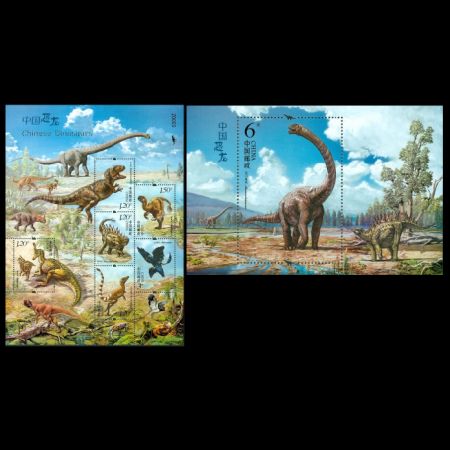
On May 19th, 2017, first time since 1958, China National Philatelic Corporation issued a set of seven dinosaur stamps: Mini-Sheet of six and a Souvenir-Sheet of one stamp with title "Chinese Dinosaurs" (stamps with the same title were issued in Hong Kong in 2014).
The two sheets show the diversity of dinosaurs, spanning some 200 million years, from the early Jurassic to the late Cretaceous periods, fossilized remains of all of them are found in various locations in China:
- Tsintaosaurus - ornithischian dinosaur from the Late Cretaceous, discovered in Laiyang, Shandong Province.
- Yangchuanosaurus - theropod dinosaur from the Late Jurassic, discovered in the region of Chongqing.
- Huayangosaurus - stegosaurian dinosaur from the Middle Jurassic, discovered in Sichuan.
- Sinosauropteryx - a smallish carnivorous dinosaur from the Early Cretaceous, discovered in Liaoning.
- Gigantoraptor - the largest known oviraptor from the Late Cretaceous, discovered in Inner Mongolia.
- Microraptor - small, four-winged dromaeosaurid dinosaur from the Early Cretaceous, discovered in Liaoning.
- Mamenchisaurus - sauropod dinosaur from the Early Cretaceous, discovered in Sichuan, Chongqing, Xinjiang and a variety of other places.
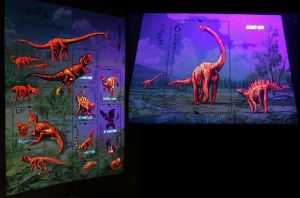 |
| Dinosaur stamps of China 2017 under UV light. |
"Dinosaurs are still with us today" and explains this by saying that dinosaurs are accepted as the ancestors of birds, and that birds make up the largest proportion of vertebrates in the world. The illustrator believes that to propagate the knowledge of dinosaurs, more ways should be used, including postage stamps, which he calls "a museum on paper".
For security reasons and to attract philatelists, the stamps were printed with special ink and used fluorescent technology that allows one to see the dinosaur bones and normally invisible security number of every stamp under UV light.
 |
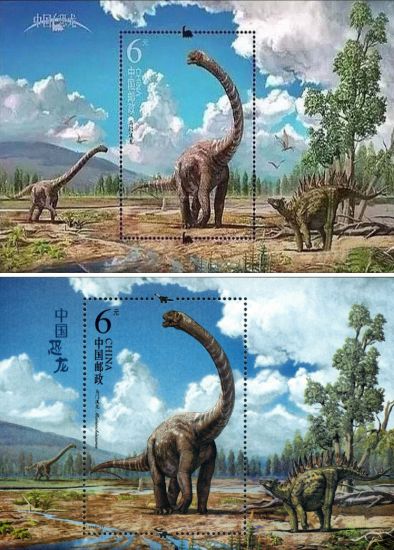 |
| Number variations of Dinosaur Mini-Sheet of China 2017. | Design variations of Souvenir-Sheet of China 2017: initial design (top) versus the final draft. |
The image on the right side shows seven different combinations of dinosaur silhouettes attached to it before the number and a letter behind it (the number itself is a running number).
The initial draft of the souvenir sheet (see on the right) is distinguished from the souvenir sheet that was released by:
- the shape of the silhouette used for the perforation at the top and bottom of the stamp changes from the initial to the final draft
- the position and color of the text on the stamp
- in the background of the selvage, the released souvenir sheet shows a young Mamenchisaurus in the background instead of the foreground
- Pterosaurs were shown in the background to both the left and right of the stamp in the selvage of the initial draft - but are missing in the final draft
- The shape and density of the clouds changed for the final draft
Among them, the non-avian dinosaurs perished from the world’s stage at the end of the Cretaceous Period (approximately 66 million years ago), and the species that were fortunate enough to avoid extinction subsequently evolved into modern-day species of birds.
China is rich in dinosaur fossils, and is often referred to as the nation with the richest dinosaur remains. Even though formal research of dinosaurs in China began at a relatively late stage, this field of study has developed rapidly.
After nearly a century, Chinese research is now at the forefront of the paleontological world. By the end of May 2014, China had officially named 244 different species of dinosaurs, ranking first overall in the world.
The discovery and research of Chinese dinosaur fossils can be traced back to 1902, when a group of fishermen discovered a skeletal fossil in the Heilongjiang River. However, it was only ten years later that Russian geologists, by virtue of this clue, discovered dinosaur fossils in Jiayin, Heilongjiang, and organized a number of field excavations.
During these excavations, those Russian geologists discovered a variety of hadrosaur skeletal fossils, and named China’s first dinosaur - the Mandschurosaurus. In addition to Heilongjiang, Shandong can also be considered one of the areas in which the earliest dinosaur fossils were discovered. It was in 1916 that the first sauropod dinosaur fossils were discovered in Ningjiagou, Mengyin, Shandong. During the period of 1922-1923, many more fossils were discovered in this area, including theropod teeth, the bone plates of a Stegosaurus, and incomplete sauropod fossils.
Early dinosaur discoveries were accidental, and uncoordinated. All first expedition was primarily led by foreign scientists, and it was only after 1930 that Chinese researchers became involved.
The true basis for the beginning of paleontological research conducted by Chinese scientists can be traced back to Lufeng, Yunnan Province.
Scientists discovered many precious dinosaur fossils here - take for example the Lufengosaurus huenei. This particular fossil is the first type of dinosaur to have officially been discovered by Chinese scientists.
Moreover, its skeleton was restored, mounted and became the first dinosaur skeleton to be featured in an exhibition. Its discovery earned Lufeng of Yunnan Province the reputation of being the “Hometown of Dinosaurs” in China, and was the first page to be written with regards to the vast and glorious history of Chinese dinosaur research and discovery.
Mamenchisaurus, featured on the Souvenir-Sheet, existed during the Late Jurassic.
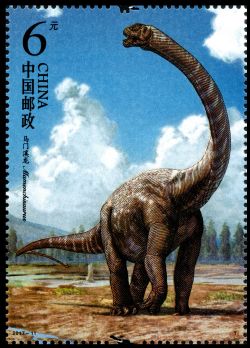 |
| Mamenchisaurus on stamp of China 2017 MiNr.: 4900, Scott: 4445 |
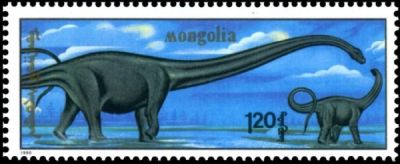 |
| The first time Mamenchisaurus appeared on stamp - Mongolia in 1990 MiNr.: 2172, Scott: 1877. |
Mamenchisaurus was enormous in size and had a sturdily built body structure.
The maximum length of an adult could reach approximately 27 meters, and they had a very long neck, which accounted for almost half of the length of its entire body.
The neck of Mamenchisaurus was set at an angle from the ground, in order to raise its head higher.
Moreover, it had a very broad chest and rounded abdomen, in addition to an enormous “tail hammer” that was positioned at the end of its tail.
The dinosaur was first discovered in 1952 at the construction site of the Yitang Highway in Sichuan, China. The partial skeleton fossil was then studied, and named Mamenchisaurus constructus in 1954, by the renowned Chinese paleontologist Professor C. C. Young, who also described and named the first mounted dinosaur of China - Lufengosaurus.
Note: Yang Zhongjian (1 June 1897 – 15 January 1979), courtesy name Keqiang, also known as C.C. (Chung Chien) Young, was one of China's foremost vertebrate paleontologists. He has been called the 'Father of Chinese Vertebrate Paleontology'.
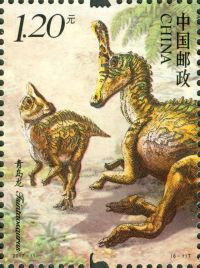 |
| Tsintaosaurus on stamp of China 2017 MiNr.: 4894, Scott: 4444a. |
It had a relatively large body structure, and a slender, tube-like spine on the very top of its head. This spine was hollow inside, and was able to be used to make sounds.
The Tsintaosaurus spinorhinus also had a large, flat-billed mouth, similar to that of a duck, teeth that lined its cheeks, a sturdy and powerful body, and long hind limbs.
The Tsintaosaurus spinorhinus used all four of its limbs to walk. The Tsintaosaurus had a very strong and powerful body, which was approximately 8 meter long, as well as a large and flat snout, and a tube-like nasal bone, which was positioned vertically on its head.
In 1950, at Hsikou, near Chingkangkou, in Laiyang, Shandong, in the eastern part of China, various remains of large hadrosaurids were uncovered.
In 1958 these were described by Chinese paleontologist Yang Zhongjian ("C.C. Young") described it as the type species Tsintaosaurus spinorhinus The generic name is derived from the city of Qingdao, earlier often transliterated as "Tsintao".
The specific name means "with a nose spine", from Latin spina, and Greek ῥίς, rhis, "nose", in reference to the distinctive crest on the snout.
Yangchuanosaurus this dinosaur lived in China during the Bathonian and Callovian stages of the Middle Jurassic, and was similar in size and appearance to its North American relative, the Allosaurus.
The earliest fossils of this specimen were discovered in Chongqing n 1976.
Yangchuanosaurus shangyouensis, which was discovered in the region of Chongqing is one of the most completely preserved carnivorous dinosaur fossils in all of China.
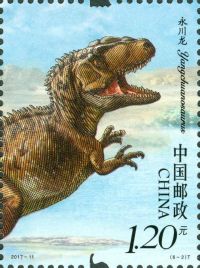
|
| Yangchuanosaurus on stamp of China 2017 MiNr.: 4895, Scott: 4444b. |
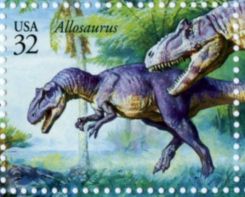
|
| Allosaurus on stamp of USA 1997 MiNr.: 2813, Scott: 3136g. |
When taking into account its sharp claws and dagger-like teeth, any prey that was unfortunate to get a glimpse of this predator would shudder with fear.
During a thunderstorm in June 1976, Lyu Xiangzhi, deputy commander of a local reservoir, was on his way to check a dam with his colleague when they stumbled upon a white object exposed from a rock.
It was very hard and looked similar to an animal bone. Later, an expert identified the fossil to be a carnivorous dinosaur head with well-preserved jaw teeth.
The local government conducted a large excavation project around where the fossil head was found. About 20 days later, a complete fossilized dinosaur was found.
This Yangchuanosaurus fossil is now preserved at the Chongqing Natural History Museum, as a major treasure of the museum.
The body of the Yangchuanosaurus was huge, with a length of approximately 8 meters. Moreover, it had a massively shaped head, and strong, razor-sharp teeth, which were serrated. They had well—developed hind limbs which allowed them to run at very fast speeds.
Huayangosaurus belongs to the Stegosauria, and lived during the Middle Jurassic.
Huayangosaurus taibaii is a medium-sized member of the Stegosauria, and it is the earliest and most completely preserved specimen of any type of Stegosaurus to have been found in the entire world (2017), based on irrefutable evidence.
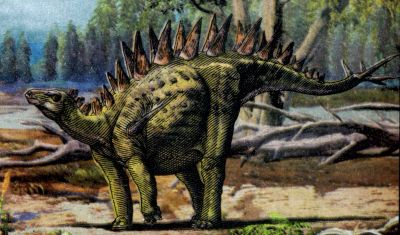 |
|
Huayangosaurus on margin of Souvenir-Sheet of China 2017
MiNr.: Bl. 229, Scott: 4445. The Souvenir-Sheet exist with some color variants. |
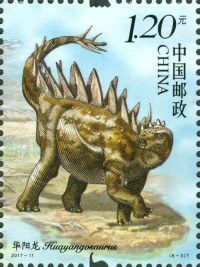 |
| Huayangosaurus on stamp of China 2017 MiNr.: 4896, Scott: 4444c. |
Huayangosaurus had features such as a double row of plates which rose vertically along its arched back, two long and sharp spines that jutted out from above its scapulas, as well as two pairs of long spikes that extended horizontally near the end of its tail and were approximately 40 cm in length.
All of these attributes were very important weapons for defensive purposes.
Like other stegosaurians, Huayangosaurus was a quadrupedal herbivore with a small skull and a spiked tail.
In 1979 and 1980, remains from twelve stegosaurian individual animals were recovered from the Dashanpu Quarry near Zigong in Sichuan. They were named and described by Dong Zhiming, Tang Zilu and Zhou Shiwu in 1982.
Sinosauropteryx, was a smallish carnivorous dinosaur that was rather compact in size, only 1~2 meters long, and its body was covered in primitive feathers.
Sinosauropteryx prima, the only species of the genus Sinosauropteryx, who lived in the Early Cretaceous, and its fossils were discovered in Liaoning Province.
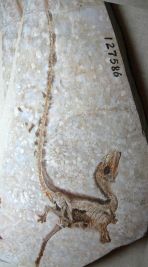 |
| Fossil of Sinosauropteryx. Images credit: Wikipedia. |
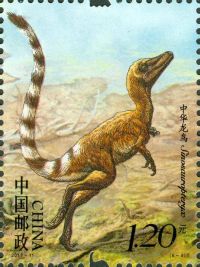 |
| Sinosauropteryx on stamp of China 2017 MiNr.: 4897, Scott: 4444d. |
Described in 1996, it was the first dinosaur taxon outside of the Avialae (birds and their immediate relatives) to be found with evidence of feathers.
It was covered with a coat of very simple filament-like feathers.
Moreover, it is also the first dinosaur to successfully have its color determined.
These feathers appeared to have been red, or reddish brown, whilst its tail feathery were speculated to have been brown and white. This creature represented the discovery of the first feathered dinosaur, and was the first instance of using scientific restoration methods to determine the color structure of a specimen.
The body structure and feathers of the Sinosauropteryx still maintained the appearance of the earliest dinosaurs, and was much more primitive in comparison to the Microraptor gui, which also existed in modern-day Liaoning.
Sinosauropteryx had 64 vertebrae in its tail. This high number made its tail the longest relative to body length of any theropod. Its hands were long compared to its arms, about 84% to 91% of the length of the rest of the arm (humerus and radius), and half the length of the foot.
The first and second digits were about the same length, with a large claw on the first digit.
The first fingers were large, being both longer and thicker than either of the bones of the forearm.
Gigantoraptor erlianensis, which was discovered in Inner Mongolia, lived during the Late Cretaceous. This was the largest known Oviraptor to have existed, 8 meters in length and weighed more than 1,400 kilograms, which is comparable to the body size of the Tyrannosaurus.
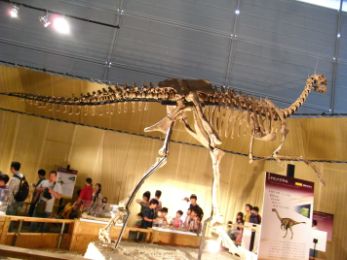 |
| Hind view of reconstructed skeleton. Image credit: Wikimedia |
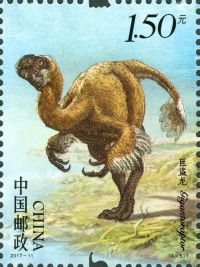 |
| Gigantoraptor on stamp of China 2017 MiNr.: 4898, Scott: 4444e. |
The researchers theorize that Gigantoraptor may have used its feathers for display or for incubating its eggs.
Past studies suggest oviraptorosaurs may have had long feathers on their arms and bodies for covering their eggs.
The diet of Gigantoraptor is uncertain.
Although some oviraptorosaurs, are thought to have been mostly herbivorous, Gigantoraptor had long hind legs with proportions that allowed for fast movement, and large claws, a combination that is not usually found in herbivores of this size, therefore it is suggested that Gigantoraptor was also a herbivore and used its speed to escape predators.
Interestingly, this creature shared more common features with modern-day birds than smaller types of Oviraptor.
Microraptor is one of the smallest dinosaurs to have ever been discovered, with body length was only 55~70 cm, and also is the first dinosaur to have been found that had four wings and was able to fly.
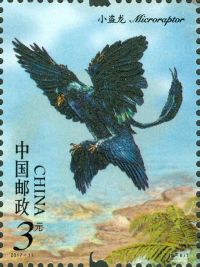 |
| Microraptor on stamp of China 2017 MiNr.: 4899, Scott: 4444f. |
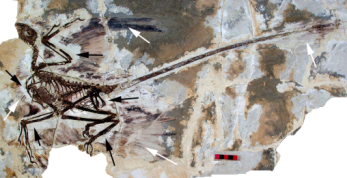 |
| Fossil of Microraptor, with white arrows pointing at preserved feathers. Image credit: Wikipedia |
Its body structure was covered with a thick layer of feathers, and its feet, head and forelimbs were also covered with feathers. Moreover, its tail featured long, fan-like tail feathers. Microraptor gui had four wings, and was considered the first flying dinosaur to exist, gliding through the woods with ease.
Microraptor had long pennaceous feathers that formed aerodynamic surfaces on the arms and tail but also on the legs.
This led paleontologist Xu Xing in 2003 to describe the first specimen to preserve this feature as a "four-winged dinosaur" and to speculate that it may have glided using all four limbs for lift.
Subsequent studies have suggested that Microraptor was capable of powered flight as well.
Microraptor was among the most abundant non-avialan dinosaurs in its ecosystem, and the genus is represented by more fossils than any other dromaeosaurid, with possibly over 300 fossil specimens represented across various museum collections.
Products and associated philatelic items
| FDC (official) | First-Day-of-Issue Postmark | |
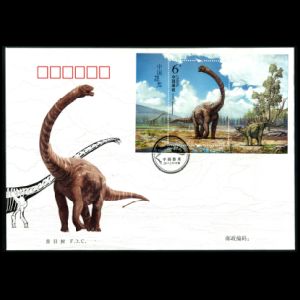 |
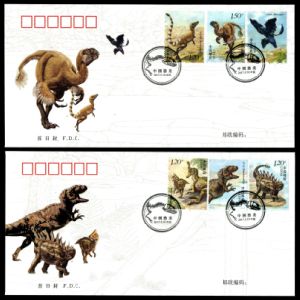 |
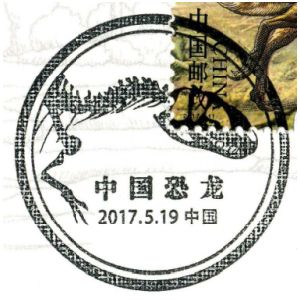 |
| Reverse side is here. | Reverse side is here. | Skull and neck of "Yangchuanosaurus" depicted on the postmark of official FDC. |
| Examples of circulated FDC (official) - posted from different places, with additional commemorative postmarks | ||
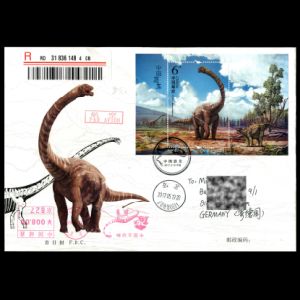 |
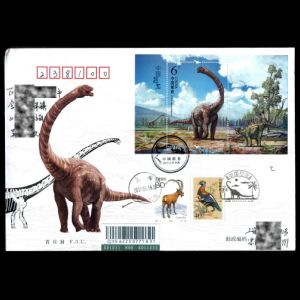 |
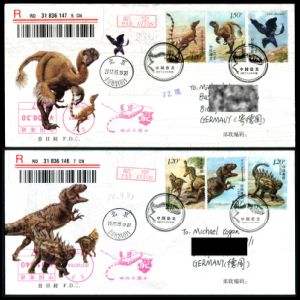 |
| Some personalized FDC (many more exist) | Booklet | |
 |
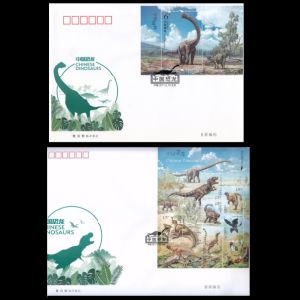 |
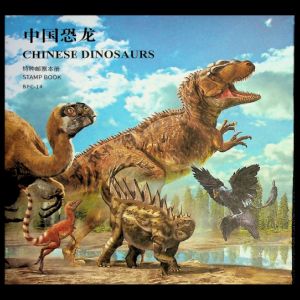 |
| Reverse side is here. | ||
| Some personalized Commemorative Covers | Siuvenir-Sheets with color variation | |
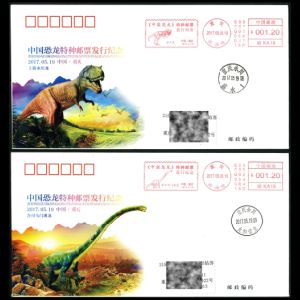 |
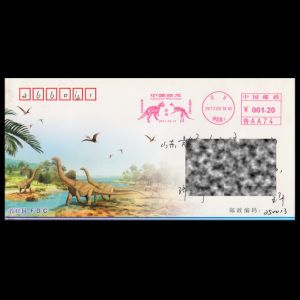 |
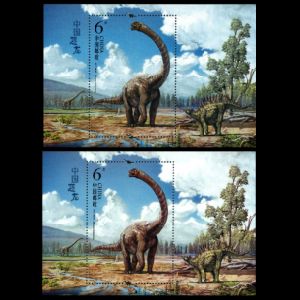 |
| Additional First-Day-of-Issue Postmarks | ||
| Mamenchisaurus, Beijing" | "Dinosaur in egg - Xixia Dino Relics Park, Nanyang City of Henan Province" | Mamenchisaurus |
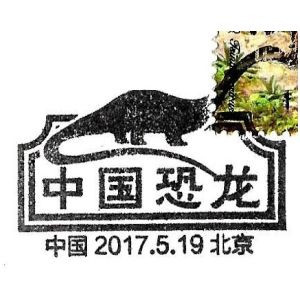 |
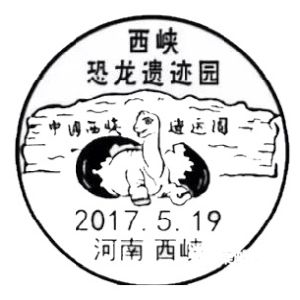 |
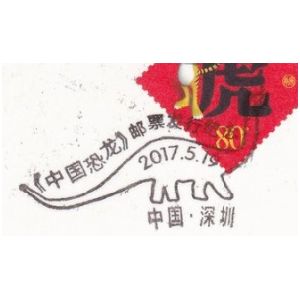 |
| "Tsintaosaurus and Gigantoraptor, Liaocheng city of Shandong province" | "Tsintaosaurus, Shenyang City of Liaoning" | "Tsintaosaurus, Laiyang of Shandong" |
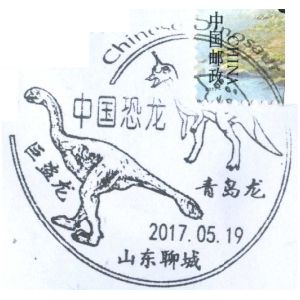 |
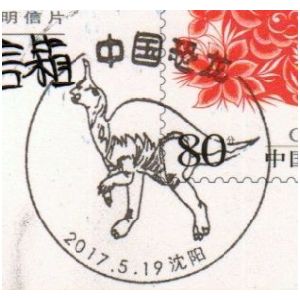 |
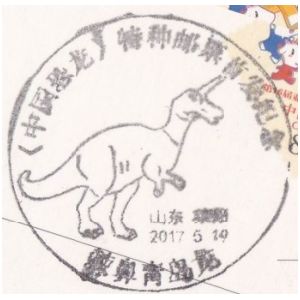 |
| "Mamenchisaurus, Yangchuanosaurus & Pteranodon, Shaoxing of Zhejiang" | "Mamenchisaurus, Yangzhou City of Jiangsu" | "Mamenchisaurus, Shanghai |
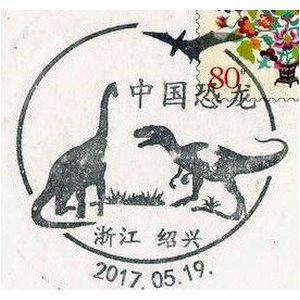 |
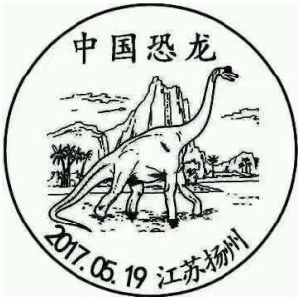 |
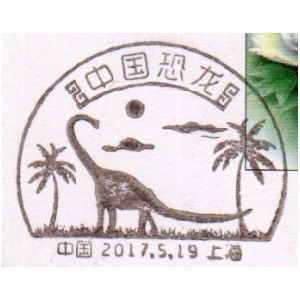 |
| "Mamenchisaurus & Pterosauria, Nanjing of Jiangsu" | "Xinjiangtitan shanshanensis, Piqan County of Xinjiang" | "Mamenchisaurus Mt Emei city of Anhui province" |
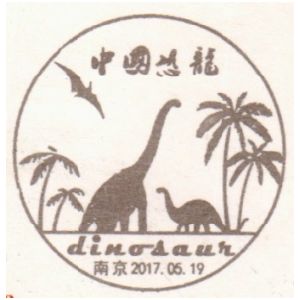 |
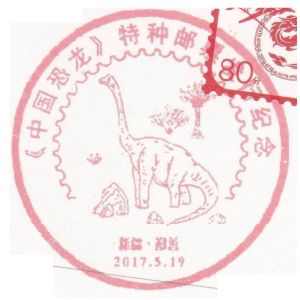 |
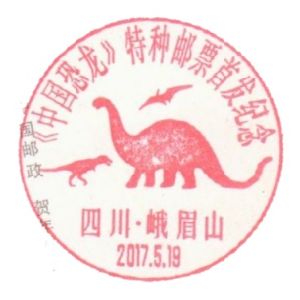 |
| "Mamenchisaurus, Changzhou city of Jiangsu province" | "M,amenchisaurus Chuzhou City of Anhui" | "Xinjiangtitan shanshanensis, Yueqing City of Zhejiang" |
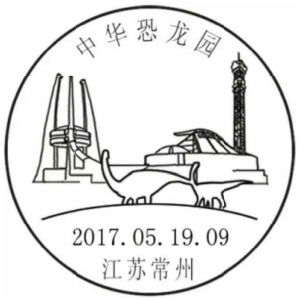 |
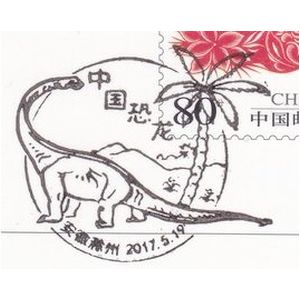 |
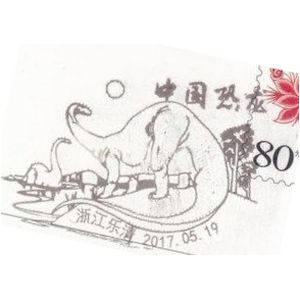 |
| "Fossil of Yangchuanosaurus, Changzhou city of Jiangsu province" | "Huayangosaurus, Hangzhou city of Zhejiang province" | "Yangchuanosaurus and Huayangosaurus" |
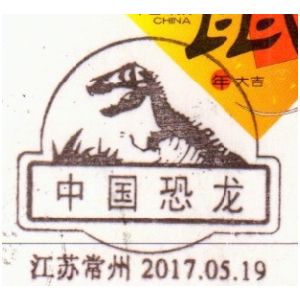 |
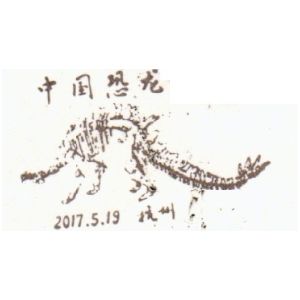 |
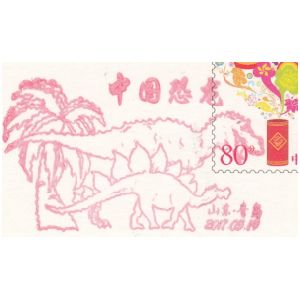 |
| "Pteranodon, Triceratops, Mamenchisaurus, Linhai of Zhejiang" [Sp] | ||
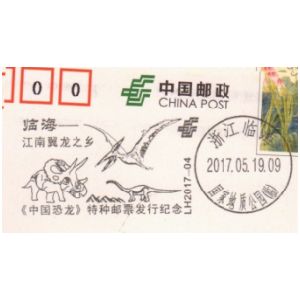 |
|
|
| Additional First-Day-of-Issue Meter frankings | ||
| "Mamenchisaurus, Beijing" | "Sinosauropteryx and Shantungosaurus, Beijing geology Museum" | "Qingdao City of Shandong Province |
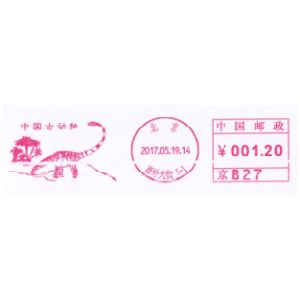 |
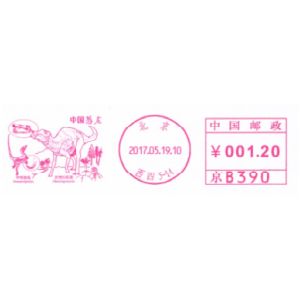 |
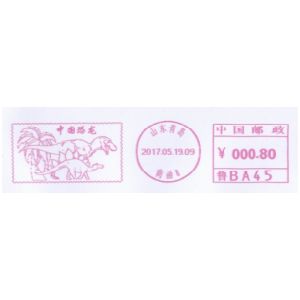 |
| "Diplodocus, Yinchuan City of Ningxia Hui Autonomous Region" | "Tsintaosaurus, Laiyang City of Shandong Province" | "Liaoning province" |
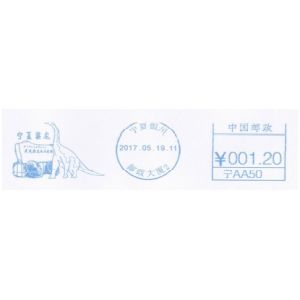 |
 |
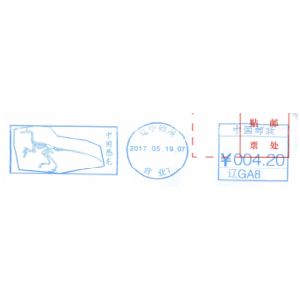 |
| "Tsintaosaurus, Jinan in Shandong province" | "Yangchuanosaurus, Chongqing city of Sichuan province" | "Mamenchisaurus, Chongqing city of Sichuan province" |
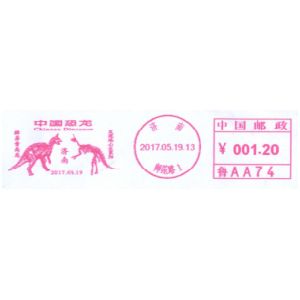 |
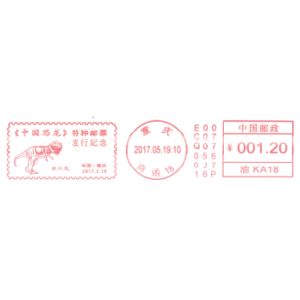 |
 |
| "China Dinosaur Land park at Changzhou" | ||
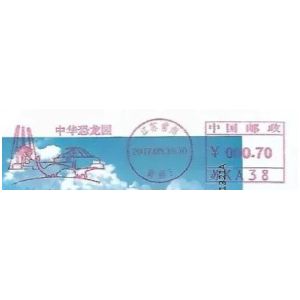 |
|
|
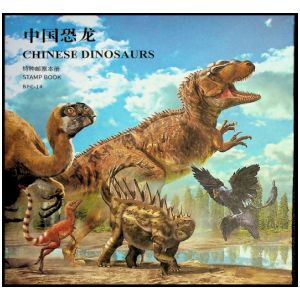 |

|
References
- Technical details and short description of the stamps:
China Post, Philaquely Moi blog, ECNS, China Daily, Back side of FDC. - Dinosaur discoveries in China:
NBC News,
"Chinese Dinosaurs" stamp book, BPC-14. Issued by China Post. Text, in Chinese and English, of stamp book by: Yang Yang (the cover is on the right). - Mamenchisaurus: Wikipedia,
- Tsintaosaurus: Wikipedia,
- Yangchuanosaurus: Wikipedia,
- Huayangosaurus: Wikipedia,
- Sinosauropteryx: Wikipedia,
- Gigantoraptor: Wikipedia,
- Microraptor: Wikipedia,
Acknowledgements
Many thanks to Dr. Peter Voice from Department of Geological and Environmental Sciences, Western Michigan University, for his help to find an information for this article, the draft page review and his very valuable comments.| <prev | back to index | next> |